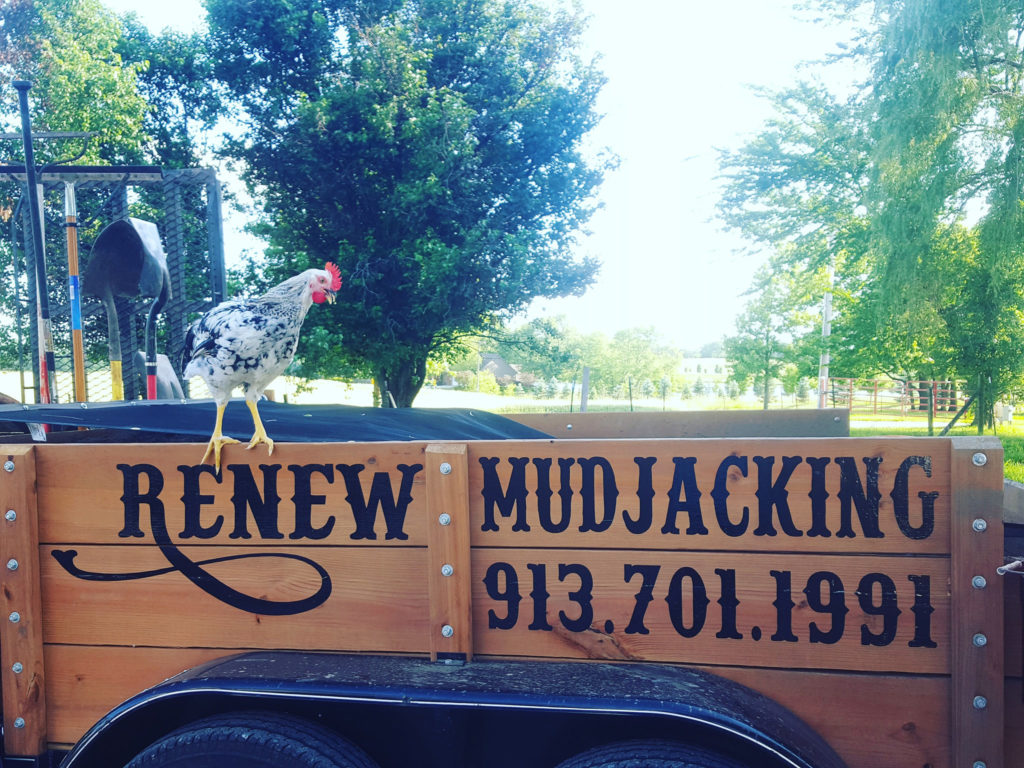
Our Services
We offer Mudjacking and Polyjacking, we serve both commercial and residential clients. Our traditional mudjacking utilizes a premium topsoil and mortar mixture, while our advanced polyjacking option features the NCFI geotechnical two-part polyurethane system for superior performance and durability.
Why do I need mudjacking/polyjacking?
When your concrete was initially poured, the ground beneath had been disrupted by various construction activities, such as foundation installation, utility placement, and water line installation. These disturbances can weaken the stability of the sub grade. Over time, the sub grade may settle, wash out, or compact under the weight of the concrete. As a result, the concrete may begin to settle unevenly, develop cracks, or form voids, compromising its structural integrity and appearance.
Who we serve
We provide mudjacking and polyjacking services to anyone in Johnson County, KS and surrounding areas (only on the Kansas side). This includes residential homeowners, commercial, and municipalities. From sidewalks, driveways, porches, steps, stoops, patios, pool decks, garage floors, or any other flatwork, our certified technicians can help provide simple, cost effective solutions.
Common Questions
How the process works.
After reaching out to us, Lydia will visit your property to conduct an assessment. During this visit, she will take detailed photos and measurements and drill small test holes, if necessary (approximately the size of a dime), which will be refilled, to accurately determine the amount of material required for your project. Following the evaluation, a detailed estimate will be prepared and emailed to you within a few business days.
Once you approve the estimate, we will schedule a time that aligns with your availability. On the scheduled date, Kevin, our experienced crew leader, and his team will complete the work by lifting, leveling, and filling any voids. After the job is finished, we ensure the area is thoroughly cleaned, and all holes are sealed with a non-shrinking concrete material for a polished and lasting result.
Polyjacking
Mudjacking
How soon can we drive or walk on the concrete?
The same day! We just ask you be mindful of the holes we drill and make sure they are dry before stepping on them. Let the material set up for 1-3 days given the weather conditions, before parking or setting large items back on the surface.
Why does concrete sink?
Sinking driveways, patios, porches, stoops, pool decks, garage floors, or any other flatwork slab:
There can be many factors:
Many homeowners in Johnson County and the surrounding areas face the challenge of settling concrete. Even under ideal conditions, using high-quality materials and best building practices, nearly all concrete slabs are susceptible to some degree of natural settling over time.
In many cases, homes are constructed so quickly that proper natural or mechanical soil compaction does not occur. Additionally, if the soil beneath the slab is insufficient or contains a high clay content (a common issue in Kansas), the likelihood of the slab cracking or sinking increases significantly.
Below are the most common causes of concrete settling:
Poorly compacted soil
Settling issues often begin before the concrete is even poured. Homes are typically constructed at such a rapid pace that there is insufficient time for natural soil compaction to occur. Additionally, contractors responsible for pouring the concrete often do not take the necessary steps to properly compact the soil using mechanical methods. This lack of preparation creates an unstable sub grade, increasing the likelihood of cracking and sinking over time.
Washout
Improper drainage is another significant factor contributing to subgrade issues. When downspouts discharge water directly at the edge of a concrete slab, it can lead to soil washout and degradation of the subgrade. Over time, this undermines the slab’s stability, increasing the risk of cracking and sinking.
Moisture content of soil
The moisture content in the soil is a critical factor in concrete settling. Clay soils, in particular, have a shrink-and-swell characteristic. As the soil absorbs and loses moisture, it expands and contracts, which leads to natural compaction over time. This process can create voids, cracks, and cause the concrete to sink. This issue becomes especially pronounced during droughts, when the soil loses moisture, leading to noticeable shrinkage and cracking.
Is maintenance needed?
Once the mudjacking or polyjacking process is complete, it is the homeowner’s responsibility to caulk any seams or cracks that were not addressed during the project and to backfill any exposed areas to contain the material and prevent future erosion. We are happy to assist with crack repairs if needed.
To preserve the integrity of the renewed concrete, it is crucial to prevent water from infiltrating beneath the slabs. We also recommend properly burying any downspouts to ensure water is directed away from the concrete and foundation, helping to maintain long-term stability.
The Process
For mudjacking
STEP 1: Evenly space out and drill 1 1/4 inch holes through the sunken concrete.
STEP 2: Carefully inject premium topsoil and mortar mixture to slowly lift and level or fill void.
STEP 3: Wash surfaces and fill with a non-shrinking concrete material.
STEP 4: Enjoy your RENEWed concrete for a fraction of the price of replacement!
For polyjacking
STEP 1: Evenly space out and drill 5/16 inch holes through the sunken concrete.
STEP 2: Carefully inject geotechnical specific polyurethane foam to slowly lift and level or fill void.
STEP 3: Wash surfaces and fill with a non-shrinking concrete material.
STEP 4: Enjoy your RENEWed concrete for a fraction of the price of replacement!
